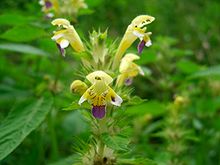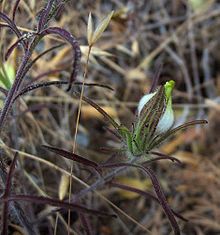| Lamiales Temporal range: Ypresian-Recent PreꞒ Ꞓ O S D C P T J K Pg N | |
|---|---|

| |
| Galeopsis speciosa | |
| Scientific classification | |
| Kingdom: | Plantae |
| Clade: | Tracheophytes |
| Clade: | Angiosperms |
| Clade: | Eudicots |
| Clade: | Asterids |
| Clade: | Lamiids |
| Order: | Lamiales Bromhead |
| Families | |
| |
| This article includes a list of general references, but it lacks sufficient corresponding inline citations. Please help to improve this article by introducing more precise citations. (May 2012) (Learn how and when to remove this message) |
The order Lamiales (also known as the mint order) are an order in the asterid group of dicotyledonous flowering plants. It includes about 23,810 species, 1,059 genera, and is divided into about 25 families. These families include Acanthaceae, Bignoniaceae, Byblidaceae, Calceolariaceae, Carlemanniaceae, Gesneriaceae, Lamiaceae, Lentibulariaceae, Linderniaceae, Martyniaceae, Mazaceae, Oleaceae, Orobanchaceae, Paulowniaceae, Pedaliaceae, Peltantheraceae, Phrymaceae, Plantaginaceae, Plocospermataceae, Schlegeliaceae, Scrophulariaceae, Stilbaceae, Tetrachondraceae, Thomandersiaceae, Verbenaceae.
Being one of the largest orders of flowering plants, Lamiales have representatives found all over the world. Well-known or economically important members of this order include lavender, lilac, olive, jasmine, the ash tree, teak, snapdragon, sesame, psyllium, garden sage, and a number of table herbs such as mint, basil, and rosemary.
Description

Plant species within the order Lamiales are eudicots and are herbaceous or have woody stems. Zygomorphic flowers are common, having five petals with an upper lip of two petals and lower lip of three petals, but actinomorphic flowers are also seen. Species potentially have five stamens, but these are typically reduced to two or four. Lamiales also produce a single style attached to an ovary typically containing two carpels. The ovary is mostly observed to be superior. The inflorescence is typically seen as cyme, raceme or spike. The fruit type is usually dehiscent capsules. Glandular hairs are present on the plants.

A number of species of carnivorous plants are found in the families Lentibulariaceae and Byblidaceae. Protocarnivorous plant species have also been found in the order, specifically in the Martyniaceae family.

Parasitic plant species are found in the order, belonging to the family Orobanchaceae. These parasitic plants can either be hemi-parasites or holoparasites.
Taxonomy
The Lamiales previously had a restricted circumscription (e.g., by Arthur Cronquist) that included the major families Lamiaceae (Labiatae), Verbenaceae, and Boraginaceae, plus a few smaller families. In the classification system of Dahlgren the Lamiales were in the superorder Lamiiflorae (also called Lamianae). Recent phylogenetic work has shown the Lamiales are polyphyletic with respect to order Scrophulariales and the two groups are now usually combined in a single order that also includes the former orders Hippuridales and Plantaginales. Lamiales has become the preferred name for this much larger combined group. The placement of the Boraginaceae is unclear, but phylogenetic work shows this family does not belong in Lamiales.
Also, the circumscription of family Scrophulariaceae, formerly a paraphyletic group defined primarily by plesiomorphic characters and from within which numerous other families of the Lamiales were derived, has been radically altered to create a number of smaller, better-defined, and putatively monophyletic families.
Dating
Much research has been conducted in recent years regarding the dating the Lamiales lineage, although there still remains some ambiguity. A 2004 study, on the molecular phylogenetic dating of asterid flowering plants, estimated 106 million years (MY) for the stem lineage of Lamiales. A similar study in 2009 estimated 80 million years. Another 2009 study gives several reasons why the issue is particularly difficult to solve.
Habitat
The Lamiales order can be found in almost all kinds of habitats world-wide. These habitats include forests, valleys, grasslands, rocky terrain, rainforests, the tropics, temperate regions, marshes, coastlines, and even frozen areas.
Uses
The order Lamiales has a variety of species with anthropogenic uses, the most popular belonging to the Lamiaceae and Acanthaceae families. Many of these species in the order Lamiales produce medicinal properties from alkaloids and saponins to help a variety of infections and diseases. These alkaloids and saponins may help with digestion, the common cold or flu, asthma, liver infections, pulmonary infections and contain antioxidant properties.
Species within the order are also known to have properties to repel insects and help control harmful diseases from insects, such as Malaria from mosquitos. Plants of the family Acanthaceae have bioactive secondary metabolites within their mature leaves, which have been found to be toxic to insect larvae. Botanical derived insecticides are a good alternate for chemical or synthetic insecticides as it is inexpensive, abundant and safe for other plants, non-target organisms and the environment.
Many species within the order are used as decorations, flavouring agents, cosmetics and fragrances. Natural dyes can also be extracted from Lamiales species. For example, in Sardinia culture, the most common Lamiales plant species used for natural dyes is Lavandula stoechas, where a light-green dye is extracted from the stem.
References
- M. E. J. Chandler. 1964. The Lower Tertiary Floras of Southern England. IV. A summary and survey of findings in the light of recent botanical observations.
- Angiosperm Phylogeny Group (2009). "An update of the Angiosperm Phylogeny Group classification for the orders and families of flowering plants: APG III". Botanical Journal of the Linnean Society. 161 (2): 105–121. doi:10.1111/j.1095-8339.2009.00996.x. hdl:10654/18083.
- Angiosperm Phylogeny Group (2016). "An update of the Angiosperm Phylogeny Group classification for the orders and families of flowering plants: APG IV". Botanical Journal of the Linnean Society. 181 (1): 1–20. doi:10.1111/boj.12385.
- ^ Allaby, Michael, ed. (2019). A Dictionary of Plant Sciences (4 ed.). Oxford University Press. doi:10.1093/acref/9780198833338.001.0001. ISBN 978-0-19-883333-8.
- ^ J. W. Kadereit, ed. (2004). Flowering plants, dicotyledons: Lamiales (except Acanthaceae including Avicenniaceae). Berlin: Springer. ISBN 3-540-40593-3. OCLC 53375899.
- ^ Schäferhoff, Bastian; Fleischmann, Andreas; Fischer, Eberhard; Albach, Dirk C; Borsch, Thomas; Heubl, Günther; Müller, Kai F (2010). "Towards resolving Lamiales relationships: insights from rapidly evolving chloroplast sequences". BMC Evolutionary Biology. 10 (1): 352. Bibcode:2010BMCEE..10..352S. doi:10.1186/1471-2148-10-352. ISSN 1471-2148. PMC 2992528. PMID 21073690.
- ^ Endress, Peter K (February 2001). "Evolution of floral symmetry". Current Opinion in Plant Biology. 4 (1): 86–91. Bibcode:2001COPB....4...86E. doi:10.1016/S1369-5266(00)00140-0. PMID 11163173.
- Westerkamp, Christian; Claßen-Bockhoff, Regine (2007-08-01). "Bilabiate Flowers: The Ultimate Response to Bees?". Annals of Botany. 100 (2): 361–374. doi:10.1093/aob/mcm123. ISSN 1095-8290. PMC 2735325. PMID 17652341.
- ^ Zhang, Caifei; Zhang, Taikui; Luebert, Federico; Xiang, Yezi; Huang, Chien-Hsun; Hu, Yi; Rees, Mathew; Frohlich, Michael W; Qi, Ji; Weigend, Maximilian; Ma, Hong (2020-11-01). Saitou, Naruya (ed.). "Asterid Phylogenomics/Phylotranscriptomics Uncover Morphological Evolutionary Histories and Support Phylogenetic Placement for Numerous Whole-Genome Duplications". Molecular Biology and Evolution. 37 (11): 3188–3210. doi:10.1093/molbev/msaa160. ISSN 0737-4038. PMID 32652014.
- McDade, L. A.; Daniel, T. F.; Kiel, C. A. (2008-09-01). "Toward a comprehensive understanding of phylogenetic relationships among lineages of Acanthaceae s.l. (Lamiales)". American Journal of Botany. 95 (9): 1136–1152. doi:10.3732/ajb.0800096. ISSN 0002-9122. PMID 21632432.
- Schäferhoff, Bastian; Fleischmann, Andreas; Fischer, Eberhard; Albach, Dirk C; Borsch, Thomas; Heubl, Günther; Müller, Kai F (2010). "Towards resolving Lamiales relationships: insights from rapidly evolving chloroplast sequences". BMC Evolutionary Biology. 10 (1): 352. Bibcode:2010BMCEE..10..352S. doi:10.1186/1471-2148-10-352. ISSN 1471-2148. PMC 2992528. PMID 21073690.
- Bremer, K.; Friis, E. M.; Bremer, B. (2004). "Molecular phylogenetic dating of asterid flowering plants shows early Cretaceous diversification". Systematic Biology. 53 (3): 496–505. doi:10.1080/10635150490445913. ISSN 1063-5157. PMID 15503676.
- Susana Magallón & Amanda Castillo (2009), "Angiosperm diversification through time", American Journal of Botany, 96 (1): 349–365, doi:10.3732/ajb.0800060, PMID 21628193
- ^ Fonseca, Luiz Henrique M. (November 2021). "Combining molecular and geographical data to infer the phylogeny of Lamiales and its dispersal patterns in and out of the tropics". Molecular Phylogenetics and Evolution. 164: 107287. Bibcode:2021MolPE.16407287F. doi:10.1016/j.ympev.2021.107287. PMID 34365014.
- ^ Sharma, Archna; Sharma, Alka; Kumar, Vijay; Kumar, Ashwini (2015). "Selected Medicinal Plants of Order Lamiales Used in Traditional Medicine". American Journal of Pharmacy and Health Research. 3 (1) – via ResearchGate.
- ^ Rawani, Anjali; Ghosh, Anupam; Chandra, Goutam (July 2014). "Mosquito larvicidal potential of four common medicinal plants of India". The Indian Journal of Medical Research. 140 (1): 102–108. ISSN 0975-9174. PMC 4181141. PMID 25222784.
- ^ Maxia, Andrea; Meli, Francesca; Gaviano, Carla; Picciau, Rosangela; De Martis, Bruno; Kasture, Sanjay; Kasture, Veene (2013). "Dye plants: Natural resources from traditional botanical knowledge of Sardinia Island, Italy". Indian Journal of Traditional Knowledge: 651–656.
External links
- Lamiales
- A parsimony analysis of the Asteridae sensu lato based on rbcL sequences
- Disintegration of the Scrophulariaceae Archived 2007-03-10 at the Wayback Machine (deals with relationships throughout Lamiales)
- L. Watson and M.J. Dallwitz (1992 onwards). The families of flowering plants: descriptions, illustrations, identification, information retrieval. http://delta-intkey.com
- Acanthaceae 2002-09-06
- https://web.archive.org/web/20070630151231/http://www.biologie.uni-hamburg.de/b-online/d52/52e.htm 2002-09-06
- https://web.archive.org/web/20070609093206/http://www.biologie.uni-hamburg.de/b-online/d52/52efam.htm 2002-09-06
- https://web.archive.org/web/20050914001131/http://www.science.siu.edu/parasitic-plants/Relation-Scroph.html
- https://web.archive.org/web/20070311032641/http://www.rbgkew.org.uk/web.dbs/genlist.html 2002-09-06
 Media related to Lamiales at Wikimedia Commons
Media related to Lamiales at Wikimedia Commons Data related to Lamiales at Wikispecies
Data related to Lamiales at Wikispecies
| Orders of flowering plants (APG IV) | ||||||||||||||||||||||||||||||||||||||||||||||||||
|---|---|---|---|---|---|---|---|---|---|---|---|---|---|---|---|---|---|---|---|---|---|---|---|---|---|---|---|---|---|---|---|---|---|---|---|---|---|---|---|---|---|---|---|---|---|---|---|---|---|---|
| Angiosperms |
|  | ||||||||||||||||||||||||||||||||||||||||||||||||